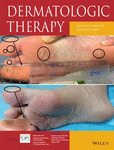Secukinumab versus ustekinumab for skin clearance in patients with moderate to severe psoriasis after a year of treatment: Real-world practice
Abstract
A descriptive retrospective, study comparing the first 29 patients who received ustekinumab at our unit following its approval in September 2009 with 30 patients who received secukinumab after its marketing in Spain in November 2015 was conducted. The secukinumab treatment group showed higher whitening rates and a higher percentage of patients reached a psoriasis area and severity index (PASI) 75 response (89.65 vs. 73.33%, p = .108) than those in the ustekinumab treatment group at Week 52. The number of patients achieving a PASI 90 response was particularly remarkable and statistically significant (82.75 vs. 43.33%, p = .002). Better PASI 75 response rates were also observed in the secukinumab group than in the ustekinumab group after 52 weeks in biologic-naïve patients (89 vs. 72%, p = .586) and among those previously treated with one line (92 vs. 100%, p = 1.00) or with two or more previous biologic lines (88 vs. 62%, p = .336). These differences were greater in the number of patients reaching a PASI 90 response in the secukinumab group than in the ustekinumab group in biologic-naïve patients (78 vs. 63%, p = .642) and in those previously treated with one (92 vs. 50%, p = .083) or with two or more treatment lines (75 vs. 31%, p = .080). These regular-practice results overlap or surpass those obtained in the CLEAR clinical trial.
CONFLICT OF INTEREST
The authors declare no conflicts of interest.




